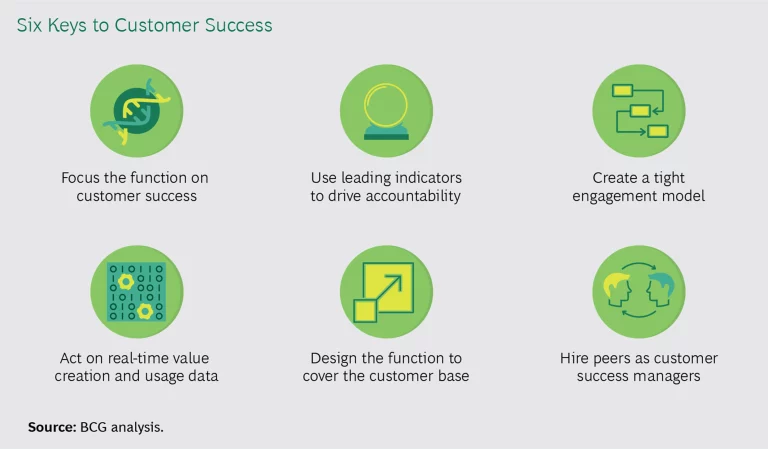Over 25X. That’s how much more value is generated over a customer’s lifetime than in the year when the customer is acquired, according to a recent BCG study of leading software as a service (SaaS) companies. No wonder CEOs believe that developing long-term customer relationships is critical for success. It’s far more profitable to retain and expand an existing customer relationship than to develop a new one. Many companies, therefore, are trying to shift from the transactional process of making one-time sales of products and services to processes—such as selling subscriptions and memberships—that help build relationships.
Although subscriptions can be effective in many industries, software companies have been among the first to pioneer this model in the form of SaaS. Unlike traditional software companies, which focus their money and time on making fresh sales, SaaS firms sell subscriptions that enable customers to use their software products for specified periods. And to ensure that this arrangement delivers results, SaaS companies are using a new customer engagement model backed by a novel organizational function: the customer success (CS) function. In this article, we will examine the CS function by drawing on the lessons we have learned from our work in the software industry.
Subscriptions Demand a New Customer Engagement Model
Two changes occur when companies sell software subscriptions rather than licenses that authorize customers to use software in perpetuity. First, the risk of adopting the product shifts from the buyer to the seller. After a one-time sale, only the customer loses out if its employees don’t use a product for which it has paid. With a subscription, however, the seller loses out if a customer doesn’t renew, since the customer acquisition cost is usually higher than the revenues earned in the initial subscription period. And the renewal will happen only if the customer has adopted the product and captured value, as measured by hard numbers or qualitative assessments. Ensuring adoption is therefore in the seller’s interest.
When companies move to a subscription-based sales model, the risk of adopting the product shifts from the buyer to the seller.
Second, the focus of value creation in the subscription model shifts from a one-time sale to a relationship, which creates opportunities for additional selling to existing customers. For example, one software vendor that offers subscriptions tripled its revenues from a customer by expanding the customer’s usage of the vendor’s product, upselling new features, and cross-selling products—all in just four years’ time.
The special elements involved in building relationships have led companies to rethink how they manage customers, as they shift from one-time transactions to a lifetime process. The new customer engagement model, called land and expand, consists of four main actions:
- Landing the customer, which relates to the process of acquiring customers
- Adopting the product, which is about ensuring that the customer uses the product
- Renewing the subscription, which relates to keeping the customer after the initial subscription expires
- Expanding the relationship, which is about growing the seller’s footprint by increasing the customer’s product usage or by selling the customer new offerings
Many companies describe the change as a shift in mindset from buying before adopting to adopting before buying. Some SaaS vendors push this further by deploying “freemium” models, in which the customer doesn’t pay anything until its adoption of the software crosses a threshold that it has agreed to in advance with the seller.
Optimizing the Customer Success Function
Existing customer-facing functions, such as marketing, sales, and after-sales service, focus too little on driving product adoption and on generating value over a customer’s lifetime. In response to this shortcoming, market leaders have created a CS function whose main purpose is to drive the adoption and optimize the use of the product, thereby maximizing value for the customer, increasing customer satisfaction, preventing churn, and driving the expansion of the seller’s business with the customer. Such a function ensures a win-win for the customer and the seller, maximizing value for the seller by increasing the product’s value to the customer.
An effectively designed CS function will maximize value for the seller by increasing the product’s value to the customer.
The maturity of the CS function varies widely in the software industry. In some companies, it’s still in its infancy, as executives think through basic design options; in others, the challenge is to optimize capabilities that already exist. In our experience, no matter how mature the CS function may be, successful companies use six levers to ensure that it generates results. (See the exhibit.)
Focus on Customer Success as the Function’s Primary Purpose
The CS function’s primary purpose is to ensure that the customer becomes more successful by using the company’s product. It achieves this objective by driving the customer’s adoption of all of the functionality offered by the product to which it has subscribed. The primary goal of a customer success manager (CSM) is not to increase customer renewals or to expand business with existing customers, but to ensure that the customer executes business processes successfully by using the seller’s product.
That said, helping a customer succeed is bound to result in desirable outcomes such as retention and expansion. If the CS function consistently drives product adoption and demonstrates the product’s value, the subscription’s renewal may well follow without any drama. But if the CS function doesn’t deliver positive business outcomes for the seller, it won’t last long. To survive, it must generate ROI through higher customer retention and expansion.
Use Leading Indicators to Drive Accountability
It is crucial for the CS function to increase recurring revenues from existing customers by reducing customer churn and by increasing upselling and cross-selling. According to a BCG–Gainsight study, renewal rate and expansion rate are the two metrics most commonly used to determine CSMs’ variable compensation. But because retention and expansion are lagging metrics, many companies also use leading indicators such as adoption. Almost half the companies in our study reported rewarding CSMs on the basis of adoption rates.
Adoption is a powerful metric because it reflects the CS function’s main responsibility and is the most accurate indicator of renewals. It’s a broad term, however, and companies need to specify what it means in each context. In order for adoption to be an effective gauge, it must include calculation of a value that will provide early warning of a churn risk. The metric should be specific to a company and its products and to a customer cohort because the values that indicate churn can vary significantly from one situation to another. For instance, Hubspot, an inbound marketing and sales platform, believes that the leading indicator of churn is use of less than 5 of the software’s 20 features during the first 60 days after purchase. At Slack Technologies, which has developed a collaboration hub, the leading renewal indicator is whether a client sends at least 2,000 team messages.
Create a Tight Engagement Model
To successfully operate a subscription business, companies must define clear-cut customer engagement models, drawing up distinct roles and identifying handoffs at each stage of the customer life cycle.
Because the CS function focuses on driving adoption, it owns all the activities related to adoption—including adoption planning, measurement, proactive training, and usage guidance—as well as business outcome planning and reviews. However, the function’s responsibilities extend throughout the customer life cycle; they don’t end after adoption. The responsibilities differ from stage to stage and from company to company, but we’ve observed a few common models at each stage.
A successful subscription business depends on having clear-cut customer engagement models.
In renewals, we’ve observed two profiles. One includes such responsibilities as contract monitoring and management; execution of the renewal; and proactive renewal risk monitoring, flagging, and management. Such a profile is more common in young firms and in companies with less mature subscription businesses.
The other profile arises in established SaaS companies, which often have in place a renewal manager role that owns the execution of the renewal process. In such cases, CS is responsible for managing the retention risk and supporting the renewal manager. Because CSMs are connected to the owners and administrators of customers’ business processes, they gain valuable insights into how each customer uses the product and, by extension, whether the customer is likely to renew its subscription. CSMs can raise a flag if a customer seems unlikely to renew its subscription; they can also identify mitigation measures and initiate actions in association with the account management team.
CS also plays a role in helping customers expand their use of the company’s products and services—a role that involves upselling and cross-selling. Who owns what in the expansion process is one of the questions we most frequently debate with clients. In this area we’ve seen three profiles, which differ in the execution of the negotiation and of the transaction. In all three profiles, CS is responsible for identifying expansion opportunities.
In some companies, the CS function owns the customer and manages both renewal and expansion. Account managers or sellers deliver the relationship to CS, which handles all negotiations related to upselling and cross-selling. In other companies, the CS team sticks to adoption, and a distinct post-landing sales role manages renewal and expansion. In this case, the CS function works closely with the sales manager and the initial seller to ensure effective onboarding of new customers. In most companies, the CS function focuses on adoption, and the seller responsible for landing the client owns the expansion process.
At the landing stage, the CS function’s responsibilities are less critical. When a company thinks that a deal is likely to go through, it may bring in the CSM to talk to the would-be customer, giving the customer a deeper understanding of what it can expect if it buys a subscription and how much the seller cares for its customers.
Finally, the CS function has a minor role to play in the product delivery and support phases. At delivery, the CS manager may try to get to know the new customer and understand how it plans to use the product, thereby commencing the relationship-building process. For technical support, the CS function must learn to escalate issues to the proper level for speedy resolution and to follow up with the technical teams when things go wrong.
Although various models exist, the scope of the CS function depends on the customer, the nature of the product, and the scale of the business. Regardless of the particular design that a company chooses, creating a clearly documented customer engagement model across functions and life-cycle stages is critical for success.
Act on Real-Time Value Creation and Usage Data
It has always been a good idea to make customers successful, but that objective becomes mission critical with subscriptions. The CS function’s ability to measure usage in real time—and to identify happy and unhappy customers on the basis of insights from usage data—allows the function to be effective and, in the long term, economical. Without data-based guidance on which customer to engage on what topic, the impact of CS and the ROI it delivers may not be as high as they could be.
Thanks to recent advances in data sciences, the process is changing from description to prediction and, increasingly, prescription. Today, CSMs can use insights from usage data to identify the actions they need to take in dealing with an at-risk customer. Companies can also gain insights from real-time value creation metrics. Overall, three distinct metrics are relevant:
- Value Creation. This key metric assesses the value that the customer generates by using the product to achieve a business outcome. The choice of outcome, of course, depends on the kind of product sold. In the case of procurement software, the relevant outcome is the reduction in costs; in manpower scheduling, it is the time required to find a replacement for a sick employee; with marketing software, it's the number and quality of qualified leads in the pipeline; and so on. For any business objective, the CS function can devise simple measures of value creation.
- Scale of Product Adoption. This criterion tracks how often the customer is using the product—a variable that many companies tend to ignore. Sellers can learn a great deal by knowing whether and how long customers are logged in to their software. When we tracked logins, it became clear to us that a customer’s number of logins was a good predictor of the likelihood of its renewing a subscription.
- Scope of Feature Adoption. CSMs can develop useful correlations and analyses by examining which features and functionality their customers use. For instance, CSMs can track the features used by the customers they retained, and compare those with the features used by lost customers. Compiling multiple analyses of this sort can help the CS function develop a predictive playbook and recommendations such as ensuring that the company has activated certain product features, given that customers that use those features invariably renew.
Design the Function to Cover the Customer Base
A company must set up its CS function to cover all of the company’s customer segments. Every customer would like to receive the function’s full array of services, but delivering them across the board isn’t economical for providers. Consequently, most companies find it effective to provide higher-touch CS, with CSMs assigned to each account, at the high end of the market, and to use lower-touch CS, with automation and alert-based deployment of CSMs, at the lower end.
Companies can cover the long tail of their customer base with automated processes. Real-time usage data helps CSMs identify customers that either are not using their products or are using them too little. They can then try to revive product adoption by sending each such customer relevant information, email messages, and in-app content highlighting the facts that the customer isn’t using the product to full effect (or at all, as the case may be), that the customer could use it differently, and that the customer would benefit from taking advantage of certain specific features.
If the customer still doesn’t increase usage, the firm may choose not to take any further action because the likely revenue doesn’t justify the cost of additional interactions. In dealing with slightly higher-ROI customers, though, vendors can set up an alert-based CS model. Although the initial intervention for them may be the same as for long-tail customers, the difference in approach becomes evident if the customer doesn’t start using the product after receiving automated communications. At that point, for higher-ROI customers, sellers can create a CSM pool, deploying CSMs to the highest-risk, highest-revenue customers on the basis of automated alerts.
Hire Peers as Customer Success Managers
The most effective CSMs are perceived as peers by the users and administrators of software products whose adoption the CSMs manage. Less impactful CSMs are seen as part of the selling company’s technical support staff or sales team.
The CS function demands domain knowledge more than it does technical or selling skills. Although CSMs must have a good working knowledge of the product’s technology, possessing business process knowledge is even more critical for the role. The best CSMs have usually managed the same process, so they can relate to customers, anticipate challenges, explain the best ways to use the product to execute the process, and drive value for customers. Their expertise helps create a trusted advisor relationship with customers.
The CS function demands domain knowledge more than it does technical or selling skills.
The ability to tailor the value proposition to different decision makers in the customer organization separates a great CSM from a good one. For example, when speaking with a department head, a CSM must lead with business value rather than functional capabilities. When talking to end users, a CSM should emphasize the impact of the software on workflows, such as time savings. When interacting with the technical team, the CSM should highlight the support that the seller will provide during the initial adoption and throughout the product’s lifetime.
Another frequently debated question is whether a company with a diverse product portfolio should develop different CSM profiles for each offering. The answer depends on the nature of the product. For example, if two products enable related business processes, a single CSM profile may contain all the relevant skill requirements. On the other hand, if the CS function must support disparate processes, multiple profiles may be necessary. It then becomes crucial to establish an effective team. In those situations, having one CSM take the lead in handling an account, together with the account managers, and in managing the internal collaboration to ensure a coordinated customer experience seems to work well.
Getting the CS Function Right Isn’t Enough
The six keys we’ve discussed will help companies build an effective CS function, but they don’t guarantee product adoption by—or value creation for—customers. Driving customer success is the entire company’s responsibility. In our experience, customer churn can result from decisions that the sales function makes to maximize revenue generation in activities such as selecting clients and setting expectations during the presale process.
Successful organizations improve the likelihood of customer success by leveraging insights from leading indicators to optimize all of their functions. For instance, product management can adjust the product roadmap to take into account common issues encountered by customers that haven’t adopted the product smoothly; marketing can define leads linked to the attributes of customers that adopt quickly; and sales can align compensation plans to consumption and customer lifetime value. Companies powered by a well-structured CS function thus have the potential to drive new levels of customer value and to grow their businesses.







